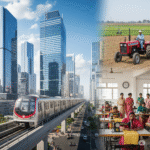Agra, 2025 – Known worldwide as the home of the iconic Taj Mahal, Agra attracts millions of tourists each year, making it one of India’s most visited cities. While tourism boosts the local economy, it also strains the city’s infrastructure and civic amenities, raising critical questions about Agra’s preparedness to handle its ever-increasing influx of visitors.
Tourism Statistics and Economic Contributions
According to the Ministry of Tourism, Agra welcomed over 8 million domestic and international tourists in 2024, contributing ₹2,000 crore to the local economy. Tourism accounts for approximately 60% of the city’s revenue, with a significant portion coming from hotel stays, food services, and transportation.
The Uttar Pradesh Tourism Department projects a 10% annual growth in tourist arrivals due to ongoing promotional campaigns and improved connectivity, including the recently inaugurated Delhi-Agra Expressway.
Strain on Infrastructure
Despite its economic importance, Agra’s civic infrastructure struggles to meet the demands of both its residents and visitors. Data from the Agra Municipal Corporation reveals that the city generates approximately 800 metric tons of waste daily, 25% of which comes from tourist hotspots. However, waste collection efficiency stands at only 70%, leading to visible littering around key attractions.
The Central Pollution Control Board (CPCB) highlights that vehicular emissions from tourist buses and taxis contribute significantly to Agra’s air pollution. The city’s Air Quality Index (AQI) frequently exceeds safe limits, particularly during peak tourist seasons.
Public transport, too, remains inadequate. A report by the Uttar Pradesh Urban Transport Corporation notes that only 40% of Agra’s residents have access to reliable public transportation, forcing tourists and locals alike to rely on private vehicles, worsening traffic congestion.
Preservation vs. Urban Growth
The Taj Mahal, a UNESCO World Heritage Site, faces its own challenges. The Archaeological Survey of India (ASI)warns that rising footfall and environmental pollutants are accelerating the deterioration of the monument’s marble. Protective measures, such as capping daily visitor numbers and introducing air purification zones, are in place but are often undermined by enforcement gaps.
Meanwhile, urban development around the Yamuna River, a key water source, has disrupted the ecological balance, according to the National Green Tribunal (NGT). This not only affects the city’s environment but also raises questions about sustainable tourism practices.
Voices from the Community
For residents, the influx of tourists is both a blessing and a burden. “Tourism creates jobs, but it also brings traffic jams and pollution,” says Sunil Gupta, a local shopkeeper near the Taj Mahal. Hoteliers like Priya Sharma argue for better planning: “We need more focus on managing the basics—cleanliness, transport, and parking facilities—so tourists leave with a positive impression.”
Tourists themselves have mixed experiences. While many praise the city’s historical beauty, others complain about overcrowding and insufficient amenities.
The Path Forward
Experts emphasize the need for an integrated approach to address Agra’s civic challenges. Key recommendations include:
- Improved Waste Management: Enhance waste collection and recycling systems, especially in tourist-heavy areas.
- Sustainable Transport Solutions: Expand public transport networks and introduce electric vehicles for tourist mobility.
- Preservation Initiatives: Strengthen enforcement of visitor limits and pollution control measures around heritage sites.
- Community Involvement: Engage residents in tourism planning to balance economic benefits with civic needs.
Conclusion
Agra’s tourism industry is a cornerstone of its economy, but it comes with substantial civic challenges. Addressing these issues is essential not only for the city’s sustainability but also for preserving its cultural and historical legacy. The question remains: Can Agra rise to the challenge and redefine its urban planning to accommodate its visitors while safeguarding its identity?








